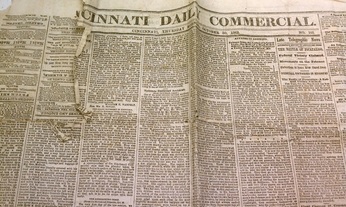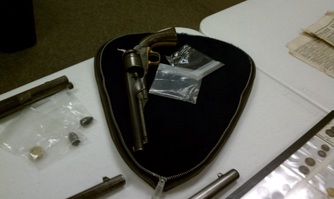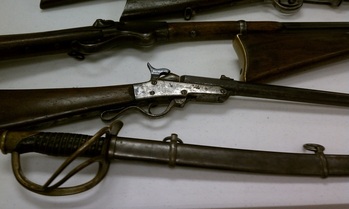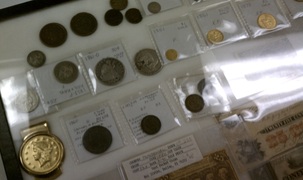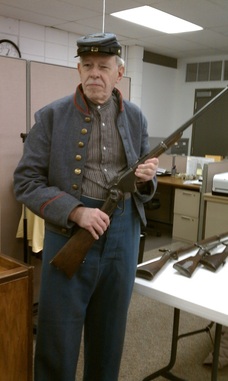Civil War history buff, Rick Cohen, was the presenter I described above. He was giving his demonstration at a recent event hosted by the Tennessee Genealogical Society. Rick is a native of Chicago who moved to Memphis about forty years ago. However, he began collecting Civil War memorabilia back in the 1960s and made it clear to the audience that he only collected and spoke about remembrances of the Union forces. Just listening to his description of his own collection was delightful. He personally owns a large number of Civil War guns, rifles and swords, as well as newspapers of that era, photographs - and even a canon! Yes, he owns a ’12-pounder’ – the type that is called a ‘boat howitzer,’ much like the one used on the Monitor of the “Monitor and Merrimack Battle” fame. He admitted that his main interest was in the Navy.
Rick brought a wonderful sampling of the various weapons used during the Civil War by the Union forces. He showed a Springfield Musket, which he explained was standard issue for the infantry by the U.S. government. It was a single muzzleloader (a holdover from previous wars) that weighed 9 ½ pounds, with each bullet loaded by being pushed all the way down the muzzle, or the open end of the barrel; not very effective, to say the least.
The Union Cavalry, on the other hand, had no standard weapons and used all types. The carbine was a special favorite. It was a short-barreled weapon that was also breech-loading, which means that a cartridge was loaded from the side or rear of the rifle and not directly down the barrel.
After showing a couple of swords, including a light-cavalry sabre, Rick showed everyone the pistols used during the war: the Colt 44, which was mostly used by the Army, and the Colt 36, mostly used by the Navy and seemingly favored by Confederate forces. The Colt 44 was the most commonly used pistol, and both were made by Samuel Colt and Company.
Finally, Rick brought out the ‘best of the best:’ the 7-shot repeater. This weapon (also known as the Spencer Repeating Rifle) included a 7-shot tubular magazine with the soldier carrying a cartridge block holding ten tubes. Although the U.S. government issued very few of these to the Union forces, according to Rick Cohen, Colonel John Wilder purchased these weapons for his own unit, which became known as the famous “Lightning Brigade.” Also according to Rick, if the U.S. government had purchased more of these weapons for the Union forces, the war would have ended much sooner. He said, unequivocally, “Firepower could have shortened the war.” (Somehow, this statement sounds very familiar. It seems that some things never change.)
Rick peppered his ‘show and tell’ of weapons and also coinage used during the Civil War with wonderful bits of history. Because most Confederate soldiers used their own weapons during the War, General Lee managed a negotiation with General Grant allowing those soldiers to take their weapons home. After all, there was no truly functioning Confederate government around to collect those firearms. It seems that the U.S. government didn’t complete a very efficient collection of weapons after the War either. There were no serial numbers on any of the weapons, many were lost in battle, and some just took their weapons home with them. Rick was not sure about the ‘accountability’ issue.
Rick also deftly handled questions from the audience. At one point, a gentleman, who had one of the most delightful Southern accents I’ve heard in quite a while, asked a question about what weapons the Confederates used. Rick conceded that the Confederate government was not able to supply their forces with weapons and most used their own rifles. Some picked up Union weapons from the battlefields, copied them, or purchased them from gunrunners from the North. The ‘Southern Gentleman,’ who seemed quite knowledgeable himself regarding Civil War weapons, stated that the Confederate government had indeed purchased most of the weapons that they were able to purchase from companies, individuals, and even government sources in the North.
As a former history teacher and lover of all things historical, I will have to say that I was not very knowledgeable about or particularly interested in military weapons. However, I thoroughly enjoyed Rick’s presentation and have come to appreciate even more what those Civil War soldiers had to endure as they went into battle with weapons which seem so primitive to us now. It brought to mind the now-infamous statement of former Secretary of Defense, Donald Rumsfeld: “You go to war with the Army you have.”
Both the Union and Confederate forces certainly did that.
(DISCLAIMER: Any incorrect descriptions of the weapons that Rick demonstrated or in the stories he told are completely the responsibility of this author, who based this piece on notes taken quickly, but as accurately as possible during the presentation.)
